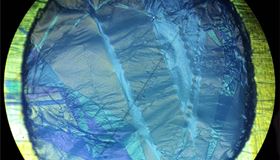 A 50nm-thick pentacene film stretched across a 2mm hole. Photo: Simon Noever, LMU.
A 50nm-thick pentacene film stretched across a 2mm hole. Photo: Simon Noever, LMU.Scientists at Ludwig-Maximilians-Universität (LMU) in Munich and Friedrich-Schiller-Universität (FSU) Jena, both in Germany, have developed organic semiconductor nanosheets that can easily be removed from a growth substrate and placed on other substrates.
Today's computer processors are composed of billions of transistors. These electronic components normally comprise a semiconductor material, insulator, substrate and electrode. Scientists would like to have each of these elements available as transferable sheets, allowing them to design new electronic devices simply by stacking the sheets together.
This has now become a reality for the organic semiconductor material pentacene. For the first time, Bert Nickel, a physicist at LMU Munich, and Andrey Turchanin at FSU Jena, together with their teams, have managed to create mechanically-stable pentacene nanosheets.
The researchers describe their method for producing these sheets in a paper in Advanced Materials. They first cover a small silicon wafer with a thin layer of a water-soluble organic material and then deposit pentacene molecules on this material to form a film roughly 50nm thick. The next step is crucial: irradiating this film with low-energy electrons causes the topmost three to four levels of pentacene molecular layers to become crosslinked, forming a ‘skin’ that is only about 5nm thick. This crosslinked layer stabilizes the entire pentacene film so well that it can be removed as a sheet from the silicon wafer in water and transferred to another surface using ordinary tweezers.
In addition to their ease of transfer, these new pentacene nanosheets have other advantages. For a start, the production method does not require any potentially interfering solvents. In addition, after deposition, the nanosheet sticks firmly to electrical contacts via van der Waals forces, conferring a low contact resistance to the final electronic device. Last but not least, the method should allow organic semiconductor nanosheets to be deposited onto significantly more technologically-relevant substrates than had been possible before.
Of particular interest is the extremely high mechanical stability of the newly-developed pentacene nanosheets, allowing them to be applied as free-standing nanomembranes to perforated substrates with dimensions of tens of micrometers. That is equivalent to spanning a 25m pool with a plastic wrap.
"These virtually freely suspended semiconductors have great potential," explains Nickel. "They can be accessed from two sides and could be connected through an electrolyte, which would make them ideal as biosensors, for example."
"Another promising application is their implementation in flexible electronics for manufacturing of devices for vital data acquisition or production of displays and solar cells," says Turchanin.
This story is adapted from material from Ludwig-Maximilians-Universitaet, with editorial changes made by Materials Today. The views expressed in this article do not necessarily represent those of Elsevier. Link to original source.